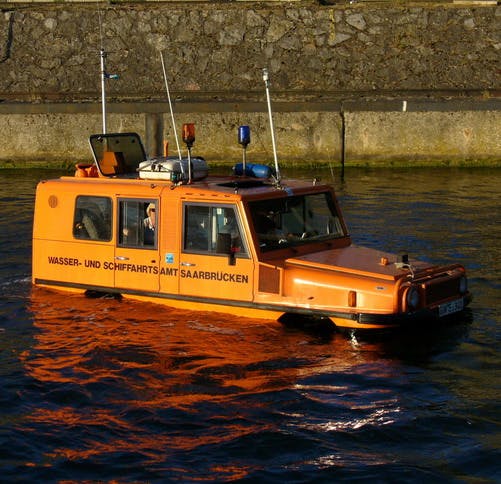Media | Articles
6 amphibious cars to “whet” your aquatic appetite
Why tow a boat behind your car when your car can also be your boat? That’s the question that makers of amphibious autos have been asking for almost 60 years. Here are six ventures into the deep end:
Amphicar
Launched at the 1961 New York Auto Show, the Amphicar Model 770 was the brainchild of Hans Trippel, whose previous claim to fame was the gullwing doors on the Mercedes-Benz 300 SL. Developed by the Quandt Group in West Germany, the Amphicar was the first attempt to mass produce an amphibious vehicle and sell it to the public. The Model 770 used the 43-hp engine from the Triumph Herald 1200 mounted at the rear and driving the either the back wheels or a pair of propellers, depending on your road- or water-going needs.
Whether at land or at sea, the steering was handled by the front wheels, which didn’t make it the most maneuverable machine. Nonetheless, two Amphicars crossed the English Channel in September 1965 in a publicity stunt. Among the 3878 cars built, one was bought by President Lyndon B. Johnson (top) who liked to bob around the lake on his Texas ranch.
Amphi-Ranger
In the mid-1980s, German oil and gas pipeline supplier Rheinauer Maschinen-und Armaturenbau was laying pipe in some pretty inaccessible places around the world. Rather than spending money on building roads and bridges, the company decided to build a vehicle that would require neither. The Amphi-Ranger was born in 1985.
Marketplace
Buy and sell classics with confidence
With four-wheel-drive and decent grunt from a Ford V-6, an aluminum body that was part G-Wagen and part paddle boat, and a retractable propeller, the Amphi-Ranger could go just about anywhere. Alongside the intended industrial use, a few German police forces operated Amphi-Rangers, while an enterprising British duo also tried to sell them to the public. That’s how one day I found myself bobbing down the Thames river in Oxford, dodging swans and undergraduates in punts, before mooring the Amphi-Ranger for a pub lunch. The vehicle was a brilliant concept, tremendous fun, and seemingly well-engineered. The price, however, was around $270,000 in today’s money. Nobody was buying. In 1995 the world waved goodbye to the Amphi-Ranger.
Dutton

Tim Dutton-Wooley was Britain’s most successful kit car manufacturer. Through the late 1960s and 1970s, garages and driveways across the U.K. were filled with half-built Lotus Seven lookalikes and curious plastic-bodied coupes. In 1989, Dutton decided it was time to do something different. Very different.
The Mariner took the running gear of a Ford Fiesta and married it with a lifeboat-inspired body and water-jet propulsion system. In 1995, British journalist Colin Goodwin crossed the 21 miles from Dover to Calais in France to prove its seaworthiness. Dutton still makes amphibious vehicle kits to this day in the form of the Fiesta-based Reef and the Suzuki Jimny-derived 4×4 Surf. A Reef kit will set you back $16,500 (plus a donor car) or $28,000 if you’d like Dutton to build it for you. For some unfathomable reason, the more complex Surf kit is actually slightly cheaper.
Hobbycar

The Hobbycar made quite a splash at the 1992 Paris Motor Show (along with the Ferrari 456 GT and E36 BMW M3). Francois Wardavoir’s jet ski with wheels was a nifty concept, with a centrally-mounted Peugeot diesel engine providing all-wheel drive on land and thrust for twin water-jets in the wet stuff. It used Citroën hydropneumatic suspension for a smooth ride and the cab-forward design, which could be tailored for commercial or leisure use, was relatively easy on the eye. The price was much harder to bear, however, at around $56,000 and only 52 were ever made in the $25 million factory. The project sunk for good in 1996.
Gibbs

The clue is in the name. New Zealand’s Gibbs High Speed Amphibians are some of the fastest machines on land and water thanks to their ingenious retractable wheel system. Simply drive into the water, push a button, and five seconds later the wheels are up and it’s full steam ahead.
In 2003, the Rover V-6-powered Aquada was the first vehicle to top 100 mph on land and 30 mph on water—fast enough to tow a waterskier. In 2004, multi-millionaire adventurer Richard Branson smashed the amphibious cross-Channel speed record by over four hours, making the crossing in just one hour and 40 minutes. At around $270,000 it was a rather pricey way for non-Branson-type folk to make the journey. Since developing the Aquada, Gibbs has used some of its 350 patents to create a whole fleet of amphibians: the Terraquad, the Quadski/Biski/Triski ATVs, and the utilitarian Humdinga and Phibian.
Watercar

California’s Watercar claims to be builders of “The Most Fun Vehicle on the Planet.” With a Guinness World Records-recognized 127 mph top speed on land and 60 mph across the water, that sounds like a fair statement. Like the Gibbs machines, the Watercar Panther retracts its wheels for watersports. Propulsion comes from a 3.7-liter Honda VTEC V-6 mounted in the rear, driving the rear wheels via a four-speed manual. For water use a transfer case sends power to stainless steel water-jet system.
It may look like the result of a drunken tryst between a Jeep Wrangler and an Excaliber, but with the level of performance on offer it’s safe to say that function triumphs over form. You’ll need plenty of liquid assets if you want one—the starting price is $158,000.
















